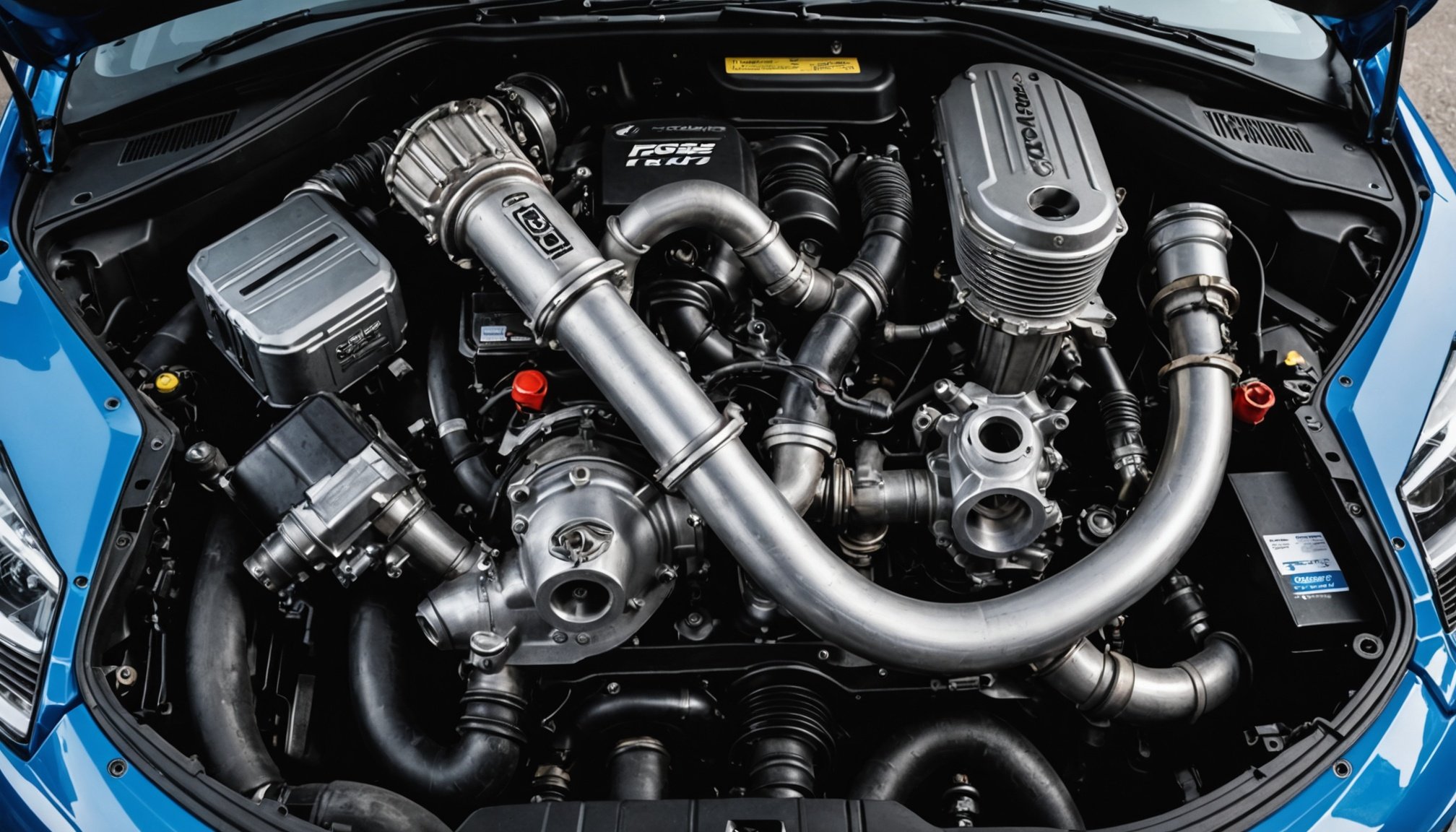Understanding Variable Geometry Turbochargers
Variable geometry turbochargers (VGTs) are a revolutionary leap in turbocharging technology. Unlike traditional turbochargers with a fixed geometry, VGTs sport adjustable vanes within the turbo housing. These vanes alter the turbocharger’s geometry based on engine load demands, enhancing efficiency. By dynamically adjusting the flow of exhaust gases to the turbine, VGTs optimise the balance between low-end torque and high-speed performance.
One of the main advantages this technology offers over traditional setups is the improvement in engine efficiency. The enhanced control over exhaust flow allows a Ford Focus RS’s performance to be maximised in different driving situations. This efficient use of exhaust gases results in an increase in the boost at lower RPMs, ultimately reducing turbo lag significantly.
Also read : Enhancing your ride: can a throttle controller eradicate lag in your toyota 86?
Additionally, variable geometry turbochargers contribute to boosted power output. Because the turbocharger can adjust its configuration, it more effectively harnesses energy across a broader RPM range. This results in a remarkable improvement in acceleration and overall engine responsiveness, essential traits for high-performance vehicles like the Ford Focus RS.
In summary, the precision control and adaptability of variable geometry turbochargers make them indispensable in modern performance-oriented automotive design, offering unmistakable enhancements in both power delivery and fuel efficiency.
In the same genre : Ultimate Guide to Safeguarding Your Jeep Wrangler”s Underbody for Thrilling Off-Road Adventures
Benefits of Upgrading to Variable Geometry Turbochargers for Ford Focus RS
Embarking on the journey of upgrading to variable geometry turbochargers for your Ford Focus RS promises an array of turbocharger benefits, providing both exhilarating performance enhancements and practical advantages. First and foremost, one of the most immediate is the enhanced throttle response. This means the engine reacts more promptly and smoothly to driver inputs, delivering a more dynamic and engaging driving experience. The magic lies in the turbocharger’s ability to vary the flow of exhaust gases, optimising output based on engine speed and load.
Beyond this exhilarating immediacy, the upgrade boasts improved power delivery characteristics. The torque curve sees remarkable enhancements across varying RPMs, effectively broadening the powerband. This ensures that whether you’re cruising at low RPMs or pushing the limits on the track, the performance feels robust and consistent.
Interestingly, while turbochargers are typically associated with boosting engine output, there are potential fuel efficiency gains to be had. By enabling engines to operate optimally over a wide range of conditions, they can sometimes deliver more bang for your fuel buck, offering a respectable blend of performance and economy.
Consider these aspects when upgrading your Ford Focus RS, and you’ll enjoy a vehicle that not only thrills but also excels in efficiency.
Installation Process for Variable Geometry Turbochargers
Installing a turbocharger can be an exciting upgrade, especially for Ford Focus RS enthusiasts. Before you begin, ensure you have all the necessary tools and components specific to turbocharger installation. Key components include the turbo unit, connection hoses, gaskets, and a mounting kit. A set of socket wrenches, torque wrench, and screwdrivers are essential tools for this installation process.
Step-by-Step Procedure
Step 1: Preparation
Start by disconnecting the battery to ensure safety. Remove any components obstructing access to the engine, such as the intake system and heat shields.
Step 2: Remove the Old Turbo
Unbolt the exhaust manifold and disconnect the oil and coolant lines. Carefully remove the existing turbocharger from the manifold.
Step 3: Install New Turbo
Attach the new turbo manifold to the engine. Connect the oil and coolant lines securely. Ensure all bolts are tightened to the recommended torque specifications.
Step 4: Connect Hoses and Wiring
Connect all necessary hoses and electrical wiring to the new turbocharger. Reinstall the previously removed components, such as the intake and heat shields.
Common Challenges and Solutions
One common challenge is aligning the turbocharger with the exhaust manifold. Utilize a thread locker to prevent bolts from loosening. If faced with coolant line leakage, double-check gasket placement. Always refer to the Ford Focus RS manual for specific recommendations on aftermarket upgrades to ensure compatibility.
Comparing Variable Geometry Turbochargers with Other Performance Upgrades
The Ford Focus RS can benefit from several performance upgrades, each with its unique advantages. Among these, exhaust systems and intercoolers are popular choices. An upgraded exhaust system, for instance, can enhance the vehicle’s ability to expel exhaust gases, reducing back-pressure and hence increasing engine power. Similarly, intercoolers are designed to lower the temperature of the air entering the engine, improving combustion efficiency and therefore boosting performance.
When comparing variable geometry turbochargers with these upgrades, their adaptability stands out. Variable geometry turbochargers adjust the flow of exhaust gases to the turbine wheel, optimising performance across a range of RPMs. This provides the Ford Focus RS with improved throttle response and efficiency compared to fixed geometry alternatives, which lack this adaptability.
Cost-Benefit Analysis
- Turbochargers: While potentially more expensive than other mods, the performance gain is substantial, offering an enhanced driving experience.
- Exhaust Systems: Generally more affordable and simple to install but offer less dramatic improvements in power gains.
- Intercoolers: Strike a balance between cost and performance enhancement by cooling intake air.
Choosing between these upgrades depends on the desired performance outcome and budget. A comprehensive turbocharger comparison reveals that variable geometry models could provide a more dynamic enhancement for enthusiasts looking to maximise their Ford Focus RS tuning potential.
Performance Metrics After Installing Variable Geometry Turbochargers
Installing a Variable Geometry Turbocharger (VGT) in a Ford Focus RS brings palpable enhancements to performance metrics. The primary expectation post-installation is a significant rise in horsepower and torque, contributing to a more dynamic driving experience. But how does this translate to real-world conditions? Through rigorous dyno testing, owners have observed notable increases in these metrics, with horsepower gains often reaching impressive numbers.
For enthusiasts keen on verifiable data, these tests provide a quantifiable look at the Ford Focus RS performance boost. Typically, aftermarket upgrades promise elevated figures in controlled environments, but real-world performance tests validate these enhancements, proving crucial for enthusiasts seeking both reliability and thrill.
Benchmarks conducted pre- and post-upgrade reveal stark contrasts. Stock performance figures serve as a baseline, showing how VGTs propel the vehicle beyond factory specifications. For instance, users report that the enhanced torque output results in quicker acceleration times, optimizing the vehicle’s responsiveness and agility.
Experiences shared by users worldwide echo this sentiment. Many describe a newfound boost in daily driving satisfaction, aligning subjective experiences with empirical data. As a result, upgrading to a VGT not only transforms the driving dynamics but also elevates the overall vehicle performance to exhilarating new heights.
Risks and Drawbacks of Variable Geometry Turbocharger Upgrades
Considering a turbocharger upgrade can be both exciting and daunting. For the Ford Focus RS, such enhancements might bring exceptional performance gains, yet they come with potential complications.
Turbocharger risks should never be underestimated. One critical issue is turbo lag, which refers to the delay between the throttle input and turbo response. This may not be prominent at higher speeds but can affect performance during rapid accelerations. Additionally, these upgrades can stress the engine, increasing wear and tear, potentially impacting the vehicle’s longevity.
Moreover, understanding the maintenance requirements of upgraded components is essential. Enhanced turbochargers might demand more frequent servicing to keep them in optimal condition. Failing to adhere to a stringent maintenance schedule could diminish the reliability of your Ford Focus RS.
Warranty considerations are significant too. Many manufacturers do not cover vehicles with modified components under their warranty schemes. Prior to proceeding with these upgrades, investigate how modifications might void existing coverage, and explore supplementary insurance plans or agreements to safeguard against possible damages.
Before upgrading, weigh the benefits against the potential drawbacks. A well-informed decision on turbocharger risks ensures that performance ambitions do not compromise the long-term health of your vehicle.
User Testimonials and Expert Opinions
For those immersed in the world of automotive performance, user experiences and expert advice are invaluable. The Ford Focus RS community thrives on shared insights about modifications such as the variable geometry turbocharger. Many enthusiasts have reported substantial improvements in performance and responsiveness, attributing these gains to the turbocharger’s ability to adjust vanes and optimise airflow.
Diving deeper, automotive experts and performance tuners often highlight several factors that bolster this upgrade’s appeal. Their insights suggest that the adaptability of a variable geometry turbocharger significantly enhances the vehicle’s acceleration by minimising turbo lag. This is especially beneficial for those seeking to refine their driving experience without compromising on performance.
Community discussions frequently explore both the pros and cons of this modification. On the positive side, users revel in a noticeable boost in horsepower and torque. However, some critiques revolve around the complexity of installation and the potential need for regular maintenance to ensure optimal function. Overall, the general consensus leans towards viewing this upgrade as a worthwhile investment for those committed to achieving peak performance in their Ford Focus RS.
Resources for Further Exploration
When undertaking upgrades on your Ford Focus RS, accessing the right resources can be a game-changer. For those considering variable geometry turbocharger upgrades, performance guides are invaluable. They offer in-depth insights into maximizing your car’s potential. Detailed installation resources are also crucial. These usually include step-by-step manuals to ensure everything goes smoothly, especially if opting for a DIY approach.
Connecting with an online Ford Focus RS community is another excellent way to stay informed. Forums allow enthusiasts to share their experiences, tips, and recommendations. This network can be a goldmine for firsthand installation feedback and troubleshooting advice. Engaging with these communities not only helps in understanding technical nuances but also fosters a sense of camaraderie with fellow RS lovers.
Additionally, identifying reputable services offering expert installations is essential. While DIY can be rewarding, professional handling often assures precision and safety. Look for businesses highlighted in community forums as trusted by other enthusiasts. This might include services known for their specialization in the Focus RS or widely recommended for their expertise with turbocharger enhancements. As part of your exploration, consider both these resources and community interactions to make informed decisions that elevate your car’s performance and enjoyment.







